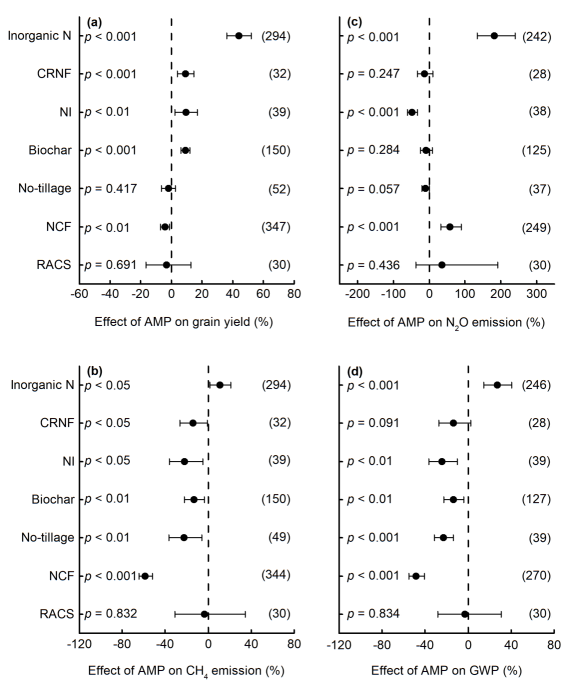我国是世界上最重要的水稻生产国。稻田是重要的甲烷人类排放源之一。因此,稻田增产减排对我国口粮安全和农业源温室气体减排具有重要意义。采用meta分析技术,黄山博士等综合评价了农艺管理措施对水稻产量和稻田温室气体排放的影响。研究结果对协同实现我国水稻增产和稻田“双碳”目标具有重要的指导价值。研究成果在中科院1区杂志Agriculture, Ecosystems and Environment上发表(Identifying agronomic practices with higher yield and lower global warming potential in rice paddies: a global meta-analysis. Agriculture, Ecosystems and Environment, 2021, 322: 107663)
主要结果如下:
Rice agriculture faces the dual challenge of increasing grain production while reducing global warming potential (GWP). Yield-scaled GWP, a commonly employed indicator, is not sufficient to identify smart agronomic practices that can address this dual challenge. Thus, practices that can increase yield while simultaneously reducing GWP in rice paddies have not yet been clearly defined. In this study, we synthesized independent experiments by meta-analyses to identify agronomic management practices with higher rice yield and lower GWP. The results showed that the application of nitrification inhibitors (NI) and biochar significantly increased rice yield by an average of 9.5% and 9.1%, and simultaneously reduced GWP by 24% and 14%, respectively. Overall, controlled-release nitrogen (N) fertilisers did not affect GWP despite increasing rice yield (+9.2%). In contrast, conventional N application enhanced both rice yield (+44%) and GWP (+27%). No-tillage reduced GWP (˗23%) but did not significantly affect rice yield. Non-continuous flooding in rice paddies significantly reduced GWP (˗48%) but also reduced the yield (˗4.2%). The rice yield and GWP outcomes were similar for rice-animal co-culture and rice monoculture systems. In conclusion, both NI and biochar application are promising practices for increasing yield while simultaneously reducing GWP in rice paddies. In addition, we suggest that individual agronomic practices should be combined to increase rice yield while mitigating climate warming.

Fig. Effects of agronomic management practices (AMP) on grain yield (a), CH4 emission (b), N2O emission (c), and GWP (d) in rice paddies. CRNF, controlled-release N fertiliser. NI, nitrification inhibitor. NCF, non-continuous flooding. RACS, rice-animal co-culture system. Numbers to the right of each bar indicate the number of observations within each practice. Error bars indicate 95% confidence intervals, and p-values indicate statistical significance of the overall effect size of each practice.